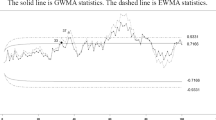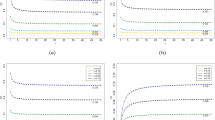Abstract
Although statistical process control (SPC) techniques have been focused mostly on detecting step (constant) mean shift, drift which is a time-varying change frequently occurs in industrial applications. In this research, for monitoring drift change, the following five control schemes are compared: the exponentially weighted moving average (EWMA) chart and the cumulative sum (CUSUM) charts which are recommended detecting drift change in the literature; the generalized EWMA (GEWMA) chart proposed by Han and Tsung (2004) and two generalized likelihood ratio based schemes, GLR-S and GLR-L charts which are respectively under the assumption of step and linear trend shifts. Both the asymptotic estimation and the numerical simulation of the average run length (ARL) are presented. We show that when the in-control (IC) ARL is large (goes to infinity), the GLR-L chart has the best overall performance among the considered charts in detecting linear trend shift. From the viewpoint of practical IC ARL, based on the simulation results, we show that besides the GLR-L chart, the GEWMA chart offers a good balanced protection against drifts of different size. Some computational issues are also addressed.
Similar content being viewed by others
References
Aerne LA, Champ CW, Rigdon SE (1991) Evaluation of control charts under linear trend. Commun Stat Theory and Methods 20: 3341–3349
Bassevile M, Nikiforov IV (1993) Detection of abrupt changes: theory and applications. Prentice-Hall, Englewood Cliffs
Bissell AF (1984) The performance of control charts and CUSUMs under linear trend. Appl Stat 33: 145–151
Capizzi G, Masarotto G (2003) An adaptive exponentially weighted moving average control chart. Technometrics 45: 199–207
Davis RB, Krehbiel TC (2002) Shewhart and zone control chart performance under linear trend. Commun Stat Simul Comput 31: 91–96
Davis RB, Woodall WH (1988) Performance of the control chart trend rule under linear shift. J Qual Technol 20: 260–262
Domangue R, Patch SC (1991) Some omnibus exponentially weighted moving average statistical process monitoring schemes. Technometric 33: 299–313
Fahmy HM, Elsayed EA (2006b) Detection of linear trends in process mean. Int J Prod Res 44: 487–504
Fahmy HM, Elsayed EA (2006a) Drift time detection and adjustment procedures for processes subject to linear trend. Int J Prod Res 44: 3257–3278
Gan FF (1991) EWMA control chart under linear drift. J Stat Comput Simul 38: 181–200
Gan FF (1996) Algorithm AS 305: average run lengths for cumulative sum control charts under linear trend. Appl Stat 45: 505–512
Han D, Tsung F (2004) A generalized EWMA control chart and its comparison with the optimal EWMA, CUSUM and GLR schemes. Ann Stat 32: 316–339
Han D, Tsung F (2005) Comparison of the Cuscore, GLRT and CUSUM control charts for detecting a dynamic mean change. Ann Inst Stat Math 57: 531–552
Han D, Tsung F (2006) A reference-free cuscore chart for dynamic mean change detection and a unified framework for charting performance comparison. J Am Stat Assoc 101: 368–386
Koning AJ, Does RJ (2000) CUSUM charts for preliminary analysis of individual observations. J Qual Technol 32: 122–132
Lai TL (1995) Sequential changepoint detection in quality control and dynamical systems. J R Stat Soc Ser B 57: 613–658
Lorden G (1971) Procedures for reacting to a change in distribution. Ann Math Stat 42: 1897–1908
Montgomery DC (2004) Introduction to statistical quality control, 5th edn. Wiley, New York
Moustakides GV (1986) Optimal stopping times for detecting changes in distributions. Ann Stat 14: 1379–1387
Pignatiello JJ, Samuel TR (2001) Estimation of the change point of a normal process mean in SPC applications. J Qual Technol 33: 82–95
Pignatiello JJ, Simpson JR (2002) A magnitude-robust control chart for monitoring and estimating step changes for normal process means. Qual Reliability Eng Int 18: 429–441
Pollak M, Siegmund D (1975) Approximations to the expected sample size of certain sequential tests. Ann Stat 3: 1267–1282
Rainer G, Castillo ED, Ratz M (2001) Run length comparisons of Shewhart charts and most powerful test charts for the detection of trends and shifts. Commun Stat Simul Comput 30: 355–376
Reynolds MR, Stoumbos ZG (2001) Individuals control schemes for monitoring the mean and variance of processes subject to drifts. Stoch Anal Appl 19: 863–892
Reynolds MR, Stoumbos ZG (2004) Control charts and the efficient allocation of sampling resources. Technometrics 46: 200–214
Ritov Y (1990) Decision theoretic optimality of the CUSUM procedure. Ann Stat 18: 1464–1469
Siegmund D, Venkatraman ES (1995) Using the generalized likelihood ratio statistics for sequential detection of a change-point. Ann Stat 23: 255–271
Srivastava MS, Wu YH (1993) Comparison of EWMA, CUSUM and Shiryayev-Roberts procedures for detecting a shift in the mean. Ann Stat 21: 645–670
Srivastava MS, Wu YH (1997) Evaluation of optimum weights and average run lengths in EWMA control schemes. Commun Stat Theory Methods 26: 1253–1267
Taylor HM (1975) A stopped brownian motion formula. Ann Probab 3: 234–246
Willsky AS, Jones HL (1976) A generalized likelihood ratio approach to detection and estimation of jumps in linear systems. IEEE Trans Automat Contr 21: 108–112
Wu YH (1994) Design of control charts for detecting the change point. In: Change-point problems. IMS, Hayward, pp 330–345
Zhao Y, Tsung F, Wang Z (2005) Dual CUSUM control schemes for detecting a range of mean shifts. IIE Trans 37: 1047–1057
Author information
Authors and Affiliations
Corresponding author
Rights and permissions
About this article
Cite this article
Zou, C., Liu, Y. & Wang, Z. Comparisons of control schemes for monitoring the means of processes subject to drifts. Metrika 70, 141–163 (2009). https://doi.org/10.1007/s00184-008-0183-6
Received:
Published:
Issue Date:
DOI: https://doi.org/10.1007/s00184-008-0183-6




